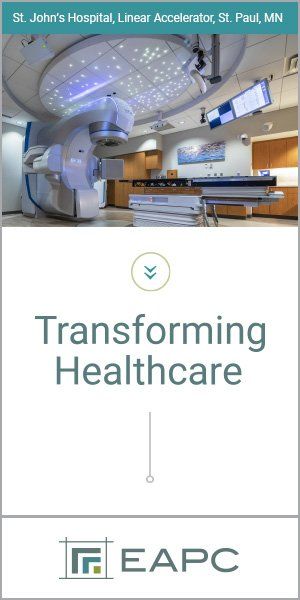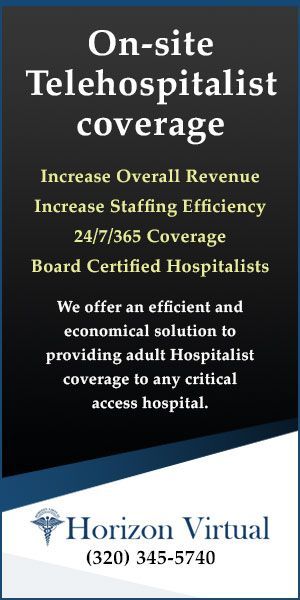Capsules
Sanford Health and Marshfield Clinic Announce Merger Plan
Sanford Health and Marshfield Clinic Health System, recently announced a nonbinding memorandum of understanding to combine their complementary assets and capabilities and create an integrated health system. Both organizations share a rich history of delivering exceptional rural health care to the patients and communities they collectively serve. “We are excited to combine our common purpose to lead the way for the future, drive innovation and solve the most pressing challenges facing rural health care,” said Bill Gassen, president and CEO of Sanford Health. “We are who we are today because of combinations with care delivery organizations in rural communities across America’s heartland. These opportunities have allowed us to follow through on our promise to deliver world-class health care to every patient we serve no matter their ZIP code, and we are eager to continue building on this track record with Marshfield Clinic Health System.” The combined nonprofit system will enable vital investment in the care of patients and communities across the rural Midwest to meet health care needs today and into the future. Over the last decade, Sanford Health has invested more than $1.5 billion in communities across South Dakota, North Dakota, Minnesota and Iowa including expanded access to specialty care and state-of-the-art facilities. “Partnering with Sanford Health presents an incredible opportunity for our organizations to unify and establish the premier rural health system in the nation,” said Brian Hoerneman, M.D., interim CEO of Marshfield Clinic Health System. “Together, we will ensure sustainable access to exceptional care for our communities for years to come. With a shared mission to serve, a mutual emphasis on research and education, and a strong tradition of physician leadership, Sanford Health is the ideal partner for this endeavor.” The combined system will bring together nearly 56,000 employees, 56 hospitals, 4,300 providers, two fully integrated health plans, specialty pharmacies and nationally recognized research institutions. Utilizing each organization’s respective health plan, Sanford Health Plan and Security Health Plan, will allow the fully integrated system to serve more than 425,000 members. Upon finalization, the name of the parent company will be Sanford Health, with system headquarters in Sioux Falls, South Dakota. The combination is expected to close by the end of the year, subject to regulatory processes and closing conditions.
Allina Nurses Protest New Admissions Plan
Nurses at Allina’s Abbott Northwestern Hospital recently released a statement about their concerns regarding a new patient admissions plan. The hospital announced implementation of a “15 Minutes to Comfort” plan that unilaterally seizes the authority of charge nurses to determine the number of patients a unit can safely care for and allows management to force patients onto unprepared units. This is a violation of the Collective Bargaining Agreement and could be counter to the Minnesota Nurse Practice Act. Nurses sent Allina management a cease-and-desist letter informing them MNA demands that such proposals first be considered and bargained at the appropriate labor management committee meeting per the collective bargaining agreement. The following is a statement from Jennifer Stanerson, Angela Becchetti and Rachael Ballard, nurses at Abbott Northwestern Hospital: “We are deeply concerned by Allina’s announcement that they will implement a ‘15 Minutes to Comfort’ patient admission plan. This process takes away the charge nurse’s ability to use their experience and expertise to staff their units safely. Instead, the decision on whether to admit a patient from the emergency department will be in the hands of an off-unit manager who cannot quickly assess the conditions. This type of decision-making will profoundly affect the safety and well-being of patients and cause overburdened nurses to take on more patients than they can safely handle. Our hospital is already losing staff. Management’s refusal to increase staffing during acute incidents of unsafe patients and working conditions has led to a dramatic increase in patient complications and patient-on-worker violence. We see increasing occurrences of pressure sores, infections, sepsis, and patient falls and more than 50 incidents of worker assault over a two-month period. Hospital management must listen to nurses, reverse these unsafe plans and procedures, and put the decision-making back in the hands of their experienced staff.” Over the last year, Allina has forced major changes to staffing in all its Twin Cities Metro hospitals, resulting in individual nurses carrying ever-increasing numbers of patients. Nurses have been advocating against these changes, arguing that the loss of staffing directly impacts patient and worker safety.
U Care Celebrates 40th Anniversary
To commemorate its 40th year in business, UCare is celebrating in a uniquely mission-centered way. Over the course of the year, the organization will convene 40 teams – among its 1,700 employees – to engage in community service projects that improve the health of communities served by UCare. Projects will focus on providing needed resources – such as food, diapers, furnishings, school supplies – to marginalized and underserved communities. “We’re celebrating the UCare way – by giving back to the community that has supported us for four decades,” said president and CEO, Hilary Marden-Resnik. “It’s an exciting time to look back and appreciate our astronomical growth in members, products and employees during these past 40 years. We are positioned to continue that growth by bringing the unique UCare expertise to serve more people in current and expansion states.” From its humble origins in 1984 as a demonstration managed care plan providing fewer than 100 Medical Assistance recipients in Hennepin County access to University of Minnesota-affiliated community clinics, the company has grown to become the state’s health plan leader in Medicaid, Medicare and individual & family plans – with 18 total products. It is the third largest government programs health plan in the nation, currently serving 600,000 members across Minnesota and in a portion of western Wisconsin. With all the changes and growth over the years, one thing has remained constant – UCare’s mission to improve the health of our members through innovative services and partnerships across communities. The incredible workplace culture also has thrived, recently earning recognition from USA Today as the most engaged workplace of any health plan in the nation. UCare kicked off its anniversary celebration with its 1,700 employees (both onsite and virtually) at a special all-employee meeting with corporate leaders recapping the organization’s impressive 40-year journey and employees from different decades relating their experiences and impressions.
New Rural Minnesota Hospital Network Announces Launch
The Headwaters High-Value Network (HVN) recently announced its launch as a collaboration of 19 independent rural Minnesota hospitals working together on clinical and business initiatives to strengthen health care in rural communities across the state. The Headwaters collaboration is a clinically integrated network (CIN) featuring 19 hospitals and more than 50 clinics providing coordinated care to more than 750,000 Minnesotans. The network also will set up operational collaborations designed to control costs and spread best practices among its members. Networks like the Headwaters HVN and the Rough Rider High-Value Network in North Dakota make up an innovative model for rural hospitals to band together to meet the mounting challenges of delivering health care in rural communities. The capabilities needed to thrive in health care today, such as controlling the rising costs of providing care and expanding care coordination, are enhanced with the economies of size and scale. Headwaters HVN will be a strong partner with payers on value-based insurance products that improve quality, reduce cost and enhance patient and provider experience. “The members of the Headwaters Network believe that helping rural hospitals to remain independent is the best way to serve the healthcare needs of our communities,” said Ken Westman, chair of the Headwaters board and CEO of Riverwood Healthcare Center in Aitkin, Minnesota. “We also believe that our independence is strengthened by our interdependence. The more we can work together, the better we can care for our communities.” The Headwaters Network is in discussions with other rural hospitals in Minnesota interested in joining as members and expects to grow. Joel Beiswenger, CEO for Headwaters member Astera Health said, “This network is yet another way that Astera Health remains independent and strong in providing care to our communities.” The Headwaters CIN will drive care coordination efforts and reduce administrative burdens for providers. The network includes a Clinical Integration Committee (CIC) to oversee all clinical and quality initiatives. “Everyone involved with Headwaters has a great sense of collaboration, a high ‘collaborative IQ,’ that will help us sustain independent hospitals for the long term,” said Ken Westman. “We understand that working together works for our communities.”
Quest Diagnostics Acquires Allina Health Lab Services
Allina Health recently announced that it had agreed to sell select laboratory services assets to nationwide leader Quest Diagnostics, ostensibly to improve access to and the affordability of innovative laboratory services across Minnesota and western Wisconsin. “We are grateful for our Allina Health laboratory team and the foundation of excellence they have established in lab services. Quest is the right partner to build on this strength to ensure providers and patients can continue to access innovative and high-quality laboratory services,” said Dominica Tallarico, chief operations officer for Allina Health. “This transaction will also allow us to reinvest our non-profit resources to support our caring mission well into the future.” With nearly 50,000 employees and one of the world’s largest databases of clinical lab results, Quest Diagnostics serves one in three adult Americans annually and half the physicians and hospitals in the United States. “Our transaction with Allina Health will extend access to Quest’s extensive service offerings in Minneapolis and throughout Minnesota and western Wisconsin,” said Jim Davis, chairman, CEO and president, Quest Diagnostics. “Quest and Allina Health share a lot in common, including a commitment to helping a range of communities benefit from quality and innovative laboratory services that people can afford. This transaction also reflects progress in delivering on our strategy, which includes generating growth through accretive laboratory acquisitions.” Quest will offer its laboratory services to Allina Health clinic physicians and outreach provider clients across Minnesota and western Wisconsin. Presuming there are no issues passing regulatory reviews, the transaction should be complete in the third quarter of this year. Allina Health expects all in-scope, eligible clinic laboratory employees at impacted locations will be offered employment with Quest, pending Quest’s customary screening process. The agreement will not change lab services until the transaction is completed, and during the process all affected patients will be kept informed about any changes to lab services. The new relationship allows Allina Health to keep pace with rapidly evolving laboratory technology and maintain excellent patient care for the communities it serves. No financial details regarding the transaction have been disclosed.
MDH Releases Inaugural List of Drugs of Substantial Public Interest
Gov. Tim Walz recently announced that the Minnesota Department of Health (MDH) has released the inaugural list of drugs that are priced significantly higher than their listed cost. This list is a result of the 2020 Minnesota Prescription Drug Price Transparency Act (the Act), designed to increase transparency in the pricing of prescription drugs. The Act required MDH to develop a system for collecting and reporting data from drug manufacturers, wholesalers, pharmacy benefit managers, and pharmacies on prescription drug prices (Minnesota Statutes 62J.84) and continue to release updates on implementation on the MDH Rx Price Transparency website. Its goal is to increase transparency in prescription drug prices by requiring drug manufactures that set high or quickly increasing prices to report price justification and other information to MDH. The inaugural list contains 364 drugs from 76 manufacturers that will now be subject to reporting from drug manufacturers, pharmacy benefit managers, wholesalers and pharmacies. The list will show how prices grow as they move through the supply chain and inform actions policymakers can take to make prescription drugs more affordable. “Access to necessary medications is a right, not a privilege. Yet, for many across the state and nation, the high cost of prescription drugs forces tough decisions when it comes to affording health care,” said Gov. Walz. “I am grateful to the Minnesota Department of Health for their crucial work in increasing transparency of the prescription drug market. This is a major step towards our goal of creating a more affordable health care system.” Publication of the drugs of substantial public interest list is a quarterly requirement of the Act. Among the first of its kind in the nation, the law will provide consumers, health care plans, policymakers and hospitals with previously unavailable information about cost drivers that impact prescription drug prices. MDH’s publication increases access to actionable information across the pharmaceutical supply chain. “This is a strong first step toward pulling back the curtain to show the cost drivers that make up prescription drug prices in Minnesota,” said Minnesota Commissioner of Health Dr. Brooke Cunningham. “The diversity of medications on the list released today provides MDH and stakeholders with more meaningful and actionable information about the prescription drug supply chain and what influences affordability.” For questions, please email health.rx@state.mn.us.
MORE STORIES IN THIS ISSUE
cover story one
Health Care at the Crossroads: Securing the future of patient care
By Lisa Schweiger, MD, and Nick VanOsdel, MD
cover story two
Talking to Adolescent Patients: A new toolkit to improve communication















